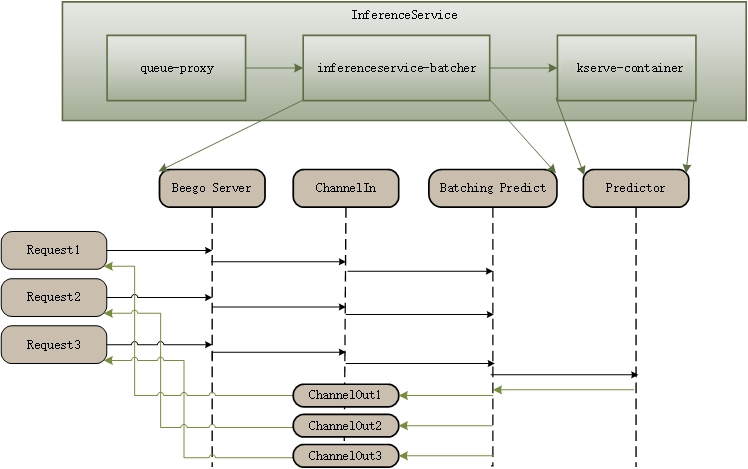Inference Batcher
This document explains how to configure batch prediction for any ML framework (TensorFlow, PyTorch, etc.) without decreasing performance.
The batcher is implemented in the KServe model agent sidecar. When requests arrive, they first hit the agent sidecar, and when a batch prediction is triggered, the request is sent to the model server container for inference.

Prerequisites
- A Kubernetes cluster with KServe installed.
- Basic understanding of KServe Concepts.
How It Works
- The model agent container is injected into the InferenceService pod using webhooks when the batcher is enabled.
- Go channels are used to transfer data between HTTP request handlers and batcher go routines.
- Currently, batching is only implemented with KServe v1 HTTP protocol; gRPC is not supported yet.
- A batch prediction is triggered when either:
- The number of instances (e.g., the number of images) reaches the
maxBatchSize, or - The waiting time reaches the
maxLatency
- The number of instances (e.g., the number of images) reaches the
Example
First, create a PyTorch predictor with a batcher. The maxLatency is set to a large value (500 milliseconds) to allow observation of the batching process.
apiVersion: serving.kserve.io/v1beta1
kind: InferenceService
metadata:
name: "torchserve"
spec:
predictor:
minReplicas: 1
timeout: 60
batcher:
maxBatchSize: 32
maxLatency: 500
model:
modelFormat:
name: pytorch
storageUri: gs://kfserving-examples/models/torchserve/image_classifier/v1
Configuration Parameters
maxBatchSize: The maximum batch size for triggering a prediction. Default: 32.maxLatency: The maximum latency for triggering a prediction (in milliseconds). Default: 500.timeout: Timeout for calling the predictor service (in seconds). Default: 60.
All these fields have default values in the code, so they are optional.
Deploying the Model
kubectl create -f pytorch-batcher.yaml
Sample Input
The following is a sample input for an image classification model:
{
"instances": [
{
"data": "iVBORw0KGgoAAAANSUhEUgAAABwAAAAcCAAAAABXZoBIAAAAw0lEQVR4nGNgGFggVVj4/y8Q2GOR83n+58/fP0DwcSqmpNN7oOTJw6f+/H2pjUU2JCSEk0EWqN0cl828e/FIxvz9/9cCh1zS5z9/G9mwyzl/+PNnKQ45nyNAr9ThMHQ/UG4tDofuB4bQIhz6fIBenMWJQ+7Vn7+zeLCbKXv6z59NOPQVgsIcW4QA9YFi6wNQLrKwsBebW/68DJ388Nun5XFocrqvIFH59+XhBAxThTfeB0r+vP/QHbuDCgr2JmOXoSsAAKK7bU3vISS4AAAAAElFTkSuQmCC",
"target": 0
}
]
}
Testing the Model
We can now send requests to the PyTorch model. First, determine the ingress IP and ports and set INGRESS_HOST and INGRESS_PORT.
MODEL_NAME=mnist
INPUT_PATH=@./input.json
SERVICE_HOSTNAME=$(kubectl get inferenceservice torchserve -o jsonpath='{.status.url}' | cut -d "/" -f 3)
hey -z 10s -c 5 -m POST -host "${SERVICE_HOSTNAME}" -H "Content-Type: application/json" -D ./input.json "http://${INGRESS_HOST}:${INGRESS_PORT}/v1/models/$MODEL_NAME:predict"
The request will go to the model agent container first, where the batcher in the sidecar container batches the requests and sends the inference request to the predictor container.
If the interval between sending two requests is less than maxLatency, the returned batchId will be the same.
Summary:
Total: 10.5361 secs
Slowest: 0.5759 secs
Fastest: 0.4983 secs
Average: 0.5265 secs
Requests/sec: 9.4912
Total data: 24100 bytes
Size/request: 241 bytes
Response time histogram:
0.498 [1] |■
0.506 [0] |
0.514 [44] |■■■■■■■■■■■■■■■■■■■■■■■■■■■■■■■■■■■■■■■■
0.522 [21] |■■■■■■■■■■■■■■■■■■■
0.529 [4] |■■■■
0.537 [5] |■■■■■
0.545 [4] |■■■■
0.553 [0] |
0.560 [7] |■■■■■■
0.568 [4] |■■■■
0.576 [10] |■■■■■■■■■
Latency distribution:
10% in 0.5100 secs
25% in 0.5118 secs
50% in 0.5149 secs
75% in 0.5406 secs
90% in 0.5706 secs
95% in 0.5733 secs
99% in 0.5759 secs
Details (average, fastest, slowest):
DNS+dialup: 0.0004 secs, 0.4983 secs, 0.5759 secs
DNS-lookup: 0.0001 secs, 0.0000 secs, 0.0015 secs
req write: 0.0002 secs, 0.0000 secs, 0.0076 secs
resp wait: 0.5257 secs, 0.4981 secs, 0.5749 secs
resp read: 0.0001 secs, 0.0000 secs, 0.0009 secs
Status code distribution:
[200] 100 responses